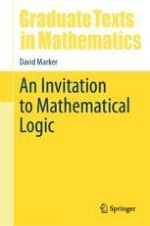2024 | OriginalPaper | Buchkapitel
5. Compactness and Complete Theories
verfasst von : David Marker
Erschienen in: An Invitation to Mathematical Logic
Verlag: Springer Nature Switzerland
Aktivieren Sie unsere intelligente Suche, um passende Fachinhalte oder Patente zu finden.
Wählen Sie Textabschnitte aus um mit Künstlicher Intelligenz passenden Patente zu finden. powered by
Markieren Sie Textabschnitte, um KI-gestützt weitere passende Inhalte zu finden. powered by
